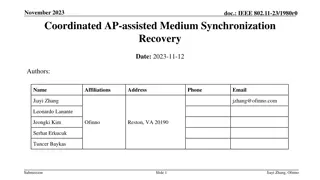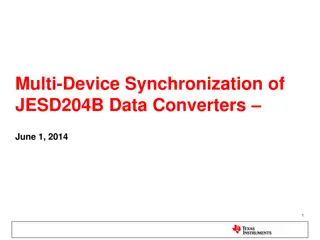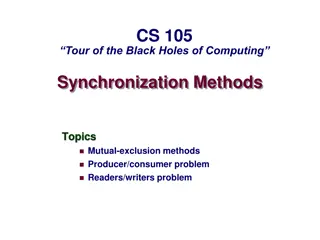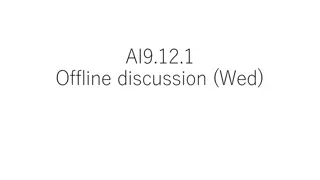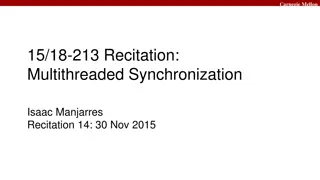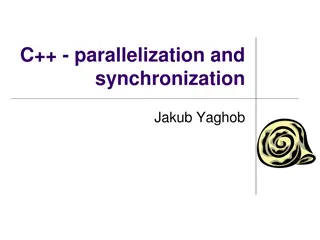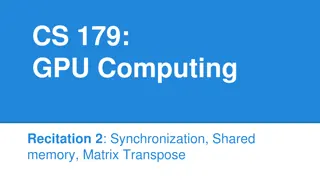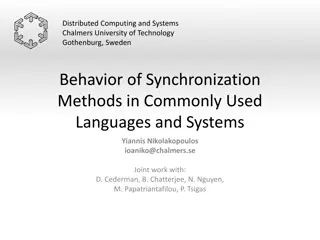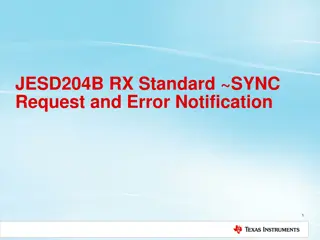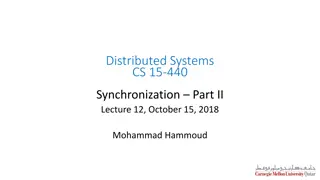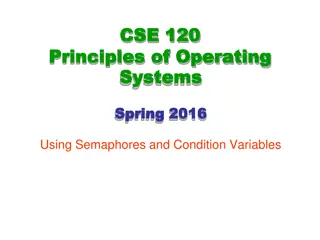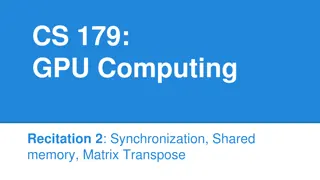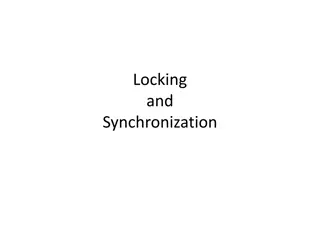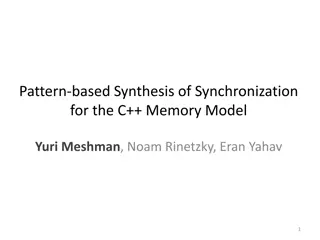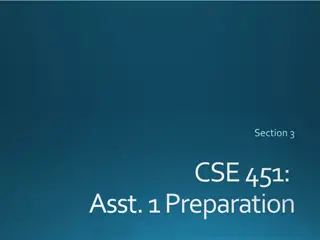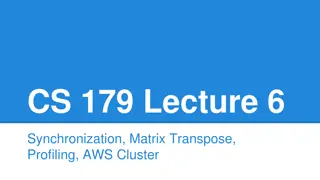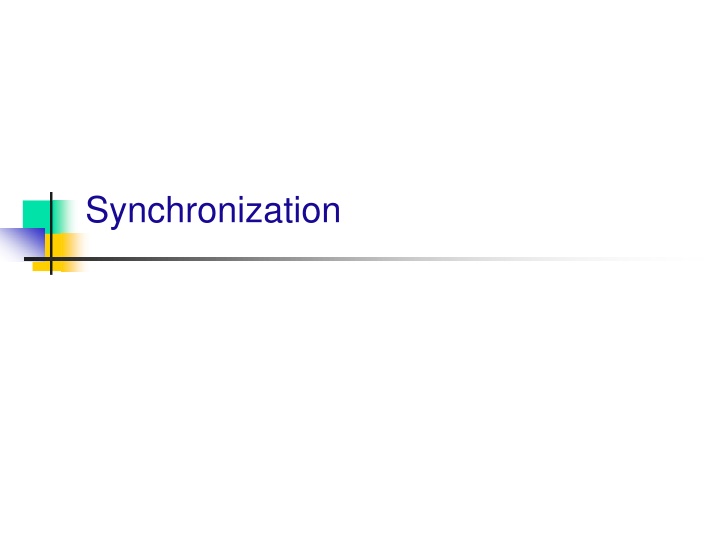
Synchronization and Mutual Exclusion in Distributed Systems
Explore the concepts of synchronization and mutual exclusion in distributed systems, including centralized and decentralized algorithms. Learn about permission-based and token-based approaches, advantages, limitations, and decentralized solutions to address bottlenecks.
Download Presentation

Please find below an Image/Link to download the presentation.
The content on the website is provided AS IS for your information and personal use only. It may not be sold, licensed, or shared on other websites without obtaining consent from the author. If you encounter any issues during the download, it is possible that the publisher has removed the file from their server.
You are allowed to download the files provided on this website for personal or commercial use, subject to the condition that they are used lawfully. All files are the property of their respective owners.
The content on the website is provided AS IS for your information and personal use only. It may not be sold, licensed, or shared on other websites without obtaining consent from the author.
E N D
Presentation Transcript
Mutual Exclusion Classification Mutual Exclusion Permission-Based Token-Based Centralized Token Ring Decentralized Distributed
PERMISSION BASED DME CENTRALIZEDALGORITHM
Centralized Algorithm Free Resource Centralized Algorithm achieves DME by closely mimicking ME in single processor systems One process, C, is the Coordinator Coordinates access to resources Other processes issue requests to access resource Request(R) 1. Request Request Resource 2. Wait for Response 3. Receive Grant Receive Grant 4. Access Resource Access Resource 5. Release Resource Release Resource P C Grant(R) Release(R)
Allocated Resource Centralized Algorithm If resource is currently by another process, C does not reply until resource is released Maintain queue of pending requests, serviced in FIFO order { { } } { {P P2 2} } { {P P2 2} } { {P P3 3} } Q C P3 Request(R) Q { {P P3 3} } Q Q P2 P1
Centralized Algorithm Advantages Easy to understand, verify and implement Access Fairness FIFO order of service is simple to implement Note FIFO policy does not guarantee Fair Share access Limitations Not scalable to large scale distributed systems Coordinator is likely to become a bottleneck A process requesting a resource cannotdistinguish between being in a blocked state , waiting for the resource to be released, from waiting for a failed coordinator Timeout mechanisms or alive messages may be required to be designed carefully to avoid early and late timeouts or unnecessary alive messages
PERMISSION BASED DME DECENTRALIZEDALGORITHM
Decentralized Permission Based DME Fully decentralized algorithms attempt to address the bottleneck problem of centralized algorithms Basic tenet of the algorithm is coordination replication and majority voting Each resource is assumed to be replicated n times Each replica has its own coordinator Therefore, n coordinators are needed
DME Decentralized Voting Algorithm Unlike in the centralized scheme, if the resource cannot be granted, a decentralized DME coordinator informs the requesting process that the resource is unavailable To gain access to a resource, a process must secure a majority votevote >=m>=? 2 ?is the number of coordinators mis the threshold of a successful majority A failed coordinator does not have to remember any vote before the crash Ignoring previously granted permissions, may lead a recovered coordinator to grant permission again to another process
Voting Algorithm Analysis T: Coordinator life time p = ? ?: Probability that a coordinator resets during ? P[k]: Probability that k out m coordinators reset during the same interval, ? ? ? = ?pk (1 p)m-k Correctness of the algorithm is violated if at least (2m-n) coordinators fail within the same interval, ? This event occurs with probability: ? ?[?] ? ?=(2? ?) For? = 32, ? = 10 sec, and m = 0.75n, the probability is 10-40 Negligible in real-life deployment
Decentralized Permissions Analysis Benefits No single point of failure Implementable using DHT based structure A resource is known under its unique name, rname The ith replica is name rname.i If permission to access a resource is denied, because the process cannot obtain a majority vote, the process backs off a random amount of time and tries again later Limitations Overhead in terms of the number of messages generated can be prohibitively high Messages to secure majority, which may require multiple attempts Failure may be difficult to handle
PERMISSION BASED DME DISTRIBUTEDALGORITHM
A Distributed ME Algorithm Ricart and Agrawala Algorithm assumes there is a mechanism for totally ordering of all events in the system and a reliable message system Lamport s algorithm can be used for total ordering A process wanting to enter a CS sends a message with (CS name, process id, current time) to all processes, including itself When a process receives a CS request from another process, it reacts based on its current state with respect to the CS requested. Three possible cases must be considered
RicartANDAgrawala Algorithm Basic Cases RA Algorithm distinguishes between 3 cases a. If the receiver is not in the CS and it does not want to enter the CS, it sends an OK message to the sender. b. If the receiver is in the CS, it does not reply and queues the request. c. If the receiver wants to enter the CS but has not yet, it compares the timestamp of the incoming message with the timestamp of its message sent to everyone The lowest timestamp wins. If the incoming timestamp is lower, the receiver sends an OK message to the sender. If its own timestamp is lower, the receiver queues the request and sends nothing.
RA DME Algorithm CS Entry and Exit After a process sends out a request to enter a CS, it waits for an OK from all the other processes. Upon receiving all OK message, process enters the CS Upon exiting CS, it sends OK messages to all processes on its queue, which are waiting for that CS Upon sending OK messages, processes are deleted from the queue.
RA Algorithm Example 8 P0 P0 P0 8 12 OK OK OK 8 P1 P2 P1 P2 P1 P2 12 OK 12 P0 and P2 request access to the same resource, nearly at the same time Both send requests with timestamps, 8 and 12, respectively Upon completion of its CS, P0 sends OK message to P2 P2 can enter its own CS P0 has the lowest timestamp, 8 P0 wins access to the resource
Distributed Permissions Analysis Benefits No central bottleneck This results in improved performance Fewer messages than the decentralized algorithm Limitations The system is exposed to npoints of failure If a node fails to respond, the entire system locks up
TOKEN BASED DME TOKEN RING ALGORITHM
A Token Ring Algorithm P2 P1 P3 P0 P2 P4 P6 P0 P4 P1 P3 P5 P7 P5 P7 P6 An unordered group of processes on a network. A logical ring constructed in software Token circulates at high speed on the network A process must have a token to enter its CS
DME Algorithm Comparison Messages per Entry/Exit Algorithm Problems Coordinator Crash Starvation, Low Efficiency 3 Centralized 2mk+m, k=1,2, K is the number of attempts, before success Decentralized 2 ( n 1 ) Process Crash Distributed Lost Token, Process Crash 1 to Token ring Centralized is the most efficient. Token ring efficient when a large of processes seek to use critical region.
ELECTION BACKGROUND
Election Algorithms Many distributed algorithms such as mutual exclusion and deadlock detection require a coordinator process. When the coordinator process fails, the distributed group of processes must execute an election algorithm to determine a new coordinator process. Different criteria can be used to select the new coordinator
Assumptions and Requirements Any process can call for an election. A process can call for at most one election at a time. Multiple processes can call an election simultaneously. Election results should not depend on which process calls for it. Each process maintains the following data structure Variable called elected An attribute value called attr The non-faulty process with the highest attribute value (e.g., highest ID or MAC address, or fastest CPU, etc.) is elected
ELECTION ALGORITHMS BULLY ALGORITHM
Bully Algorithm Main Characteristics OperatingAssumptions Synchronous system All messages arrive within TM units transmission of time. A reply is dispatched within PP units of processing time after the receipt of a message. If no response is received in 2 TM + PP, the node is assumed to be faulty Node crashed Attribute = Process ID Each process knows all the other processes in the system Therefore, processes know each others IDs
The Bully Algorithm When any process, P, notices that the coordinator is no longer responding it initiates an election: P sends an electionmessage to all processes with higher id numbers. If no one responds, P wins the election and becomes coordinator. If a higher process responds, it takes over. Process P s job is done. 1. 2. 3.
The Bully Algorithm At any moment, a process can receive an election message from one of its lower-numbered colleagues. The receiver sends an OK back to the sender and conducts its own election. Eventually only the bully process remains. Bully process becomes the new coordinator The bully announces victory to all processes in the distributed group.
Bully Algorithm Example Process 4 notices 7 down. Process 4 holds an election. Process 5 and 6 respond, telling 4 to stop. Now 5 and 6 each hold an election.
Bully Algorithm Example Process 6 tells process 5 to stop Process 6 (the bully) wins and tells everyone If processes 7 recovers, it restarts election process
Performance of Bully Algorithm Best case scenario: The process with the second highest id notices the failure of the coordinator and elects itself. N-2 coordinator messages are sent. Turnaround time is one message transmission time. Worst case scenario: When the process with the least id detects the failure. N-1 processes altogether begin elections, each sending messages to processes with higher ids. The message overhead is O(N2). Turnaround time is approximately 5 message transmission times if there are no failures during the run: election, answer, election, answer, coordinator
ELECTION ALGORITHMS RING ALGORITHM
Ring Algorithm Basic Operation RA assumes that the processes are logically ordered in a ring {implies a successor pointer and an active process list} that is unidirectional. When any process, P, notices that the coordinator is no longer responding it initiates an election: 1. P sends message containing P s process ID to the next available successor.
Ring Algorithm Basic Operation 2. At each active process, the receiving process adds its process number to the list of processes in the message and forwards it to its successor. Eventually, the message gets back to the sender. 3. The initial sender sends out a second message letting everyone know who the coordinator is {the process with the highest number} and indicating the current members of the active list of processes.
Ring Algorithm Example Even if two ELECTIONS start at once, every node will pick the same leader.


